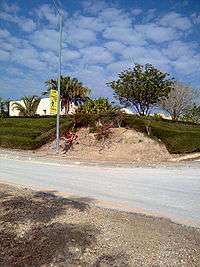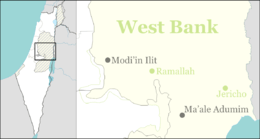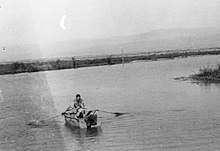Beit HaArava
Beit HaArava (Hebrew: בֵּית הָעֲרָבָה, lit. House of the Arava) is an Israeli settlement and kibbutz in the West Bank. Located near the Dead Sea and Jericho at the eponymous Beit HaArava Junction, the intersection of Highway 1 and Highway 90, it falls under the jurisdiction of Megilot Regional Council. In 2018 it had a population of 290.
Beit HaArava בֵּית הָעֲרָבָה | |
|---|---|
 | |
 Beit HaArava | |
| Coordinates: 31°48′29.51″N 35°28′32.87″E | |
| Country | Israel |
| District | Judea and Samaria Area |
| Council | Megilot |
| Region | West Bank |
| Founded | 1939 (original) 1980 (re-establishment) |
| Founded by | Youth Aliyah members |
| Population (2018)[1] | 290 |
| Name meaning | House of the Arava |
The international community considers Israeli settlements in the West Bank illegal under international law, but the Israeli government disputes this.[2]
History
The village was originally established in 1939 by European members of Zionist youth movements who had fled Nazi Germany to Mandatory Palestine via Youth Aliyah.[3] David Coren, later a member of the Knesset, was also amongst the founders. It was named after the biblical village of the same name allocated to the tribe of Benjamin (Joshua 18:22), located in the Arabah plain, and means "House in the Desert".[4] According to the Jewish National Fund, the Kibbutz became famous for its experiments in land reclamation, the residents reclaiming land that had never been previously cultivated.[4] Zvi Dror published a history of the founding of BeitHaArava in 1994, entitled Shutfut Bema'aseh Habria (English literal translation, "Participating in the Act of Creation")[5]

In 1947, Beit HaArava had a population of over 200.[4] On 20 May 1948, after a failure to reach an agreement with Transjordan's King Abdullah, Beit HaArava and the nearby Kalia were abandoned due to their isolation during the fighting of the 1948 Arab–Israeli War. The residents of the villages evacuated to the Israeli post at Sodom.[6] Its members were later temporarily housed in kibbutz Shefayim, and ultimately split into two groups which in 1949 founded the kibbutzim of Gesher HaZiv and Kabri in the Western Galilee.
According to ARIJ, in 1980 Israel confiscated 506 dunams of land from the Palestinian site of Nabi Musa in order to construct Beit HaArava.[7]
In 1980, Beit HaArava was re-established as a Nahal outpost. It became a civilian community in 1986. In 2000, the site of village moved 5 kilometres westwards. Today Beit HaArava has 70 families, 30 of them members of the kibbutz, numbering approximately 400 people, with an increase of 36,5% in 2019 being the fastest growing municipality in the whole of Israel.[8]
Economy
The world's largest operating solar pond for electricity generation was the Beit HaArava pond, which was operated until 1988. The pond had an area of 210,000 m² and produced an electrical output of 5 MW.[9]
References
| Wikimedia Commons has media related to Beit Ha'arava. |
- "Population in the Localities 2018" (XLS). Israel Central Bureau of Statistics. 25 August 2019. Retrieved 26 August 2019.
- "The Geneva Convention". BBC News. 10 December 2009. Retrieved 27 November 2010.
- "Beit HaArava: Blooming in the salty earth" (in Hebrew). Ynet. 2005-05-13. Retrieved 2008-05-16.
- Jewish National Fund (1949). Jewish Villages in Israel. Jerusalem: Hamadpis Liphshitz Press. p. 18.
- Shapiro, Sraya (13 March 1994). "THE MEN WHO DARED: SETTLERS OF BEIT HA'ARAVA (book review)". Jerusalem Post.
- Nur, Eviatar, ed. (1978). Carta's Atlas of Israel - The First Years 1948-1961. Jerusalem, Israel: Carta.
- An Nabi Musa Locality Profile, ARIJ, p. 7
- israel today, April 2020, p.42
- Solar Ponds. "Solar Ponds, Solar Thermal Magazine". Solarthermalmagazine.com. Archived from the original on 2012-03-22. Retrieved 2012-06-08.